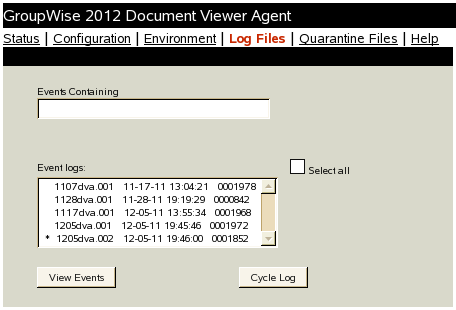49.3 Using DVA Log Files
Error messages and other information about DVA functioning are written to log files as well as displaying on the DVA server console (Windows only). Log files can provide a wealth of information for resolving problems with DVA functioning. Logging is enabled by default.
49.3.1 Locating DVA Log Files
The default location of the DVA log files varies by platform:
|
Linux: |
|
|
Windows: |
c:\Program Files\Novell\GroupWise Server\Agents\gwdva.dir\log |
You can change the location where the DVA creates its log files, as described in Configuring DVA Log Settings.
49.3.2 Configuring DVA Log Settings
-
Open the gwdva.dva file in a text editor.
-
Search to find the Log Switches section.
-
Adjust the following log settings as needed:
--loglevel: There are three log levels:
-
Normal (default) Displays warnings and errors.
-
Verbose: Displays the Normal log level information, plus information messages and user requests.
-
Diagnostic: Displays all possible information. Use Diagnostic only if you are troubleshooting a problem with the DVA.
The Verbose and Diagnostic log levels do not degrade DVA performance, but log files consume more disk space when Verbose or Diagnostic logging is in use.
--log: For the default location of DVA log files, see Section 49.3.1, Locating DVA Log Files. Specify a different location for DVA log files as needed.
--logdays: Specify the number of days you want to retain the log files. The DVA retains log files for the specified number of days unless the maximum disk space for the log files is exceeded. The default age is 30 days.
--logmax: Specify the maximum amount of disk space you want to use for DVA log files. If the disk space limit is exceeded, the DVA deletes log files, beginning with the oldest file, until the limit is no longer exceeded. The default disk space is 102400 KB (100 MB).
-
-
Save the gwdva.dva file.
-
Skip to Section 48.4, Putting DVA Configuration Changes into Effect.
49.3.3 Viewing DVA Log Files
For the default location of the DVA log files, see Section 49.3.1, Locating DVA Log Files
When logging is turned on, the DVA creates a new log file each day and each time it is restarted. Therefore, you find multiple log files in the log file directory. The first four characters represent the date (mmdd). The next three characters identify the agent (dva). A three-digit extension allows for multiple log files created on the same day. For example, a log file named 0518dva.001 indicates that it is a DVA log file created on May 18.
For convenience, you can view DVA log files in the DVA Web console:

49.3.4 Interpreting DVA Log File Information
On startup, the DVA records the DVA settings currently in effect. Thereafter, it logs events that take place, including errors.
Because the DVA consists of multiple threads, you might find it useful to retrieve the log file into an editor and sort it on the thread ID that follows the date and time information. Sorting groups all messages together for the same DVA thread. You can also use the search capability of the DVA Web console to gather information about events that contain a specific string.